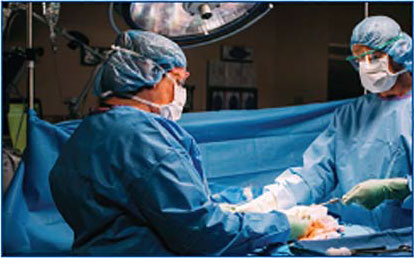Surgical Draping: Minimize SSI Risk by Using Proper Technique

Healthcare associated infections (HAIs), and more specifically surgical site infections (SSIs), can send a patent down a path of serious illness, well beyond the original cause for surgical care. HAIs typically result in longer hospital stays or extended outpatient care, making these errors costly for hospitals.
Prevention of SSIs is best achieved by adhearing to evidence-based sterile practices within the perioperative suite. Performing appropriate surgical draping procedures plays a substantial role in minimizing the patient's rick for acquiring an SSI.
Draping Technique - It's Material to Minimizing Infection Risk
The inherent purpose of drapes is to act as a barrier to prevent microorganisms from settling or migrating near the surgical site. Proper placement of sterile drapes allows for access to the surgical site with minimal exposure to potential contaminants. The choice of draping materials is varied and selection for use is determined by suitability for the procedure being performed. Draping material should be anti-static, low linting, flame resistant, and able to block blood and fluid penetration.

Perioperative team members should be familiar with AORN's Guideline for Surgical Draping and the protocols specific to the surgery type. The CineMed AORN video module, Surgical Draping: Evidence-based Practices, offers visual instruction on draping methods for many types of procedures.
Unsterile equipment, such as microscopes, robot arms, and other equipment that may be used in or near the sterile field, should also be draped to minimize the risk of contaminating the sterile field. The recommended practice is to perform all draping as close to the procedure time as possible to minimize the potential for microbes to settle on or migrate to surfaces.

Movement Awareness Offers Another Line of Defense
While surgical drapes function as a barrier to contamination, they are not foolproof. A break in sterile technique can expose the sterile area to contamination, which is why it is important for all perioperative team members, both scrubbed and unscrubbed, to remain vigilant while moving in the vicinity of the sterile field. Precautions should be taken to minimize movement between scrubbed and unscrubbed team members to avoid exposing the sterile field to unsterile elements. Following AORN's evidence-based guidelines for best practices, combining appropriate draping principles with team members' adherence to aseptic techniques, aids in reducing a patient's risk of aquiring an SSI.
Learn how to apply these principles in your OR by watching the Surgical Draping: Evidence-based Practices video module and completing the study guide, both part of the CineMed AORN Online Perioperative Education program available at https://cine-med.com/aornonline.

